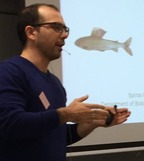Overview
The programme aims to provide graduate level education with an interdisciplinary approach as regards the management, visualization and processing of big data as well as the relevant computational techniques and technologies and is targeted towards graduates and professionals who wish to broaden their knowledge in the field.
For almost half a century now, the world has been producing and collecting data in digital form. However, the past decade hardware and network advances have allowed for very large, cost-effective storage and powerful processing as well as fast transfer speeds. At the same time, scientists have been developing software tools for the analysis of big and complex data, to extract valuable knowledge from them. The goal of data scientists is to make sense of large volumes of different forms of real-world data that may come from the entire spectrum of human activity.
Data Science nowadays is an “umbrella term” that encompasses a variety of scientific fields. Essentially, it is an interdisciplinary field that combines a multitude of different disciplines, some of the most important being the following:
- Artificial Intelligence & Machine Learning
- Statistics & Mathematics
- Database and Big Data technology
- Software Development & Algorithmics
However, the above list is not exhaustive, as a data scientist often needs to employ other skills, such as hacking, coding, critical thinking, problem understanding etc. All those make the job of the data scientist to be a mashup of different skills that are rarely found together.
Students who apply for the MSc in Data Science of the International Hellenic University, are mainly graduates with a STEM (Science, Technology, Engineering and Mathematics) or an Economics degree, who have a background in statistics and a good knowledge of fundamental concepts of databases and programming.
The courses of the programme are taught exclusively in English. The academic staff comes from Universities in Greece and abroad.
Official Government Gazette:

Start date: October 2023
Application deadline extension: 30 September 2023 or until places are filled
Campus: Thermi, Thessaloniki
Duration/Mode: 18 months (full-time) or 30 months (part-time)/(available also in distance learning mode)/weekdays evenings
Taught language: English
Entry requirements: An undergraduate degree from an accredited University
Language requirements: English language knowledge documented with a relevant certificate, corresponding at least to the State Certificate of Language Learning Level B2 or other certificate proving good knowledge of English. Holders of an undergraduate or postgraduate degree at a Foreign University in English are exempt from this obligation.
Fees: 3,700€ (total)
How to apply: Programme announcement- 2nd Phase of Admission of Graduate Students (en+gr)


Who can apply
To be considered for the programme, candidates are required to have:
- an undergraduate degree from a recognized University
-
English language knowledge documented with a relevant certificate, corresponding at least to the State Certificate of Language Learning Level B2 or other certificate proving good knowledge of English. Holders of an undergraduate or postgraduate degree at a Foreign University in English are exempt from this obligation.
Course content
Upon arrival at the IHU all students follow an intensive foundation course titled “Applied Mathematics in ICT” that aims to bring all incoming students to the same level with respect to some of the mathematics knowledge that is required to excel in the programme. During the first term, all students are required to attend five mandatory core courses. During the second term, all students follow a further three required courses and a combination of two elective courses. Finally, during the third term, work is dedicated exclusively to the Master’s dissertation.
The core courses
1st Term Core Courses
2nd Term Core Courses
The elective courses
During the second term students tailor their programme further by choosing elective courses. The choice of elective courses must sum up to 12 ECTS (2 courses). Some of the elective courses may not be offered in a particular year, depending entirely on student demand. 2nd Term Elective Courses
The Dissertation
During the third term, students work on their Masters Dissertation project, the thematic area of which is relevant to their programme of studies and their interests. The dissertation provides a good opportunity to apply theory and concepts learned in different courses to a real-world Data Science problem or challenge. Students are supervised throughout their projects by a member of the academic faculty and the academic assistants. After submission of the dissertation, students present their projects to classmates and faculty at a special event.
Duration of studies
The duration of the full-time study programme in order to obtain the MA degree is three (3) academic semesters. For students who so wish, there is also the possibility, upon request, of attending the programme on a part–time basis. In this case, the duration of the MA will be five (5) academic semesters. Lectures mainly take place on weekday evenings. The programme is also available through distance learning. Distance Learning teaching methods involve: (a) Face-to-face or classroom based learning: Students will be required to be physically present at the University for a weekend at the beginning of each semester (b) Synchronous learning: Student will have to attend remotely the classes which will be held regularly during each semester, weekday afternoons (about 2-4 times per week depending on the mode, always after 17:00) and possible Saturday morning (c) Asynchronous learning: Students will use online learning resources and will be assessed through a variety of diagnostic tools and formative assessment techniques (d) Summative assessment: Students will be typically required to be physically present at the University for the final exams at the end of each semester.
The Academic Faculty
Faculty Members
 |
Dr Christos Tjortjis Associate Professor
Dean of the School +30 2310 807576 c.tjortjis@ihu.edu.gr |
 |
Professor Maria Drakaki
Deputy Dean of the School +30 2310 807524 mdrakaki@ihu.gr |
 |
Professor Panayiotis Bozanis
+30 2310 807501 pbozanis@ihu.gr |
 |
Dr Eleni Heracleous
Associate Professor e.heracleous@ihu.edu.gr |
 |
Dr Vassilios Peristeras Associate Professor
+30 2310 807539 v.peristeras@ihu.edu.gr |
 |
Dr Dimitrios Tzetzis Associate Professor
+30 2310 807548 d.tzetzis@ihu.edu.gr |
 |
Dr Spiros Papakostas Assistant Professor
spapakostas@ihu.edu.gr |
Other Research and Teaching Personnel
 |
Dr Christos Berberidis Research and Teaching Staff +30 2310 807534 c.berberidis@ihu.edu.gr |
 |
Dr Dimitrios Baltatzis Research and Teaching Staff d.baltatzis@ihu.edu.gr |
 |
Dr Georgios Martinopoulos Academic Associate +30 2310 807533 g.martinopoulos@ihu.edu.gr |
 |
Dr Leonidas Akritidis Academic Associate |
 |
Dr Dimitrios Karapiperis Academic Associate |
 |
Dr Paraskevas Koukaras Academic Associate |
 |
Dr Nikolaos Serketzis Academic Associate |
 |
Dr Katerina Tzafilkou Academic Associate |
Visiting Faculty
- Prof. Stavros Stavrinides
- Prof. Apostolos Papadopoulos
- Prof. Konstantinos Diamantaras
- Prof. Nikolaos Bassiliades
- Dr. Theodoros Semertzidis
- Dr. Nikolaos Vretos
Fees & Financing
Fees
The programme fees for the MSc in Data Science is 3,700€. The amount is payable in two instalments for the full time mode or in four instalments for the part time mode at the beginning of each semester. The fees are also eligible for financing through LAEK 0,45% – OAED programme.
Deposits
If you have been accepted to a postgraduate programme, you will need to make a payment of the deposit of 500 Euros to secure your place. This amount will count towards the first instalment of your tuition fees. The deposit is non-refundable once you have commenced your studies at the IHU. Prior to that, a refund can be made but a 20% administrative fee will be retained. The deposit can be paid by bank transfer or bank draft. Credit card payments can be made through electronic banking (contact your Bank as handling fees may apply).
Scholarships
The School of Science & Technology offers a number of scholarships for the programmes it offers, covering a significant proportion of the fees. These scholarships are competitive. Award criteria include the quality of the first degree, the undergraduate grades of the candidate, his/her command of the English language and overall profile. Candidates for scholarships should include a separate letter with their application documents in which they request to be considered for a scholarship, stating the reasons why they think they qualify.
Programme announcement – Admissions
Next MSc in Data Science class starts in October 2023. The application deadline for the MSc programme has been extended. Interested parties are invited to submit their application from July 1st, 2023 to September 30th, 2023 or until places are filled, by following instructions at the application page.
Ideal Career path
According to the European Commission’s European Data Market study the number of “data companies” as well as the need for “data workers” are already high and it is expected to grow even more in the near future. Depending on the focus of your study and skills, there are several career paths you can follow; the list below, although it is non-exhaustive, it covers the spectrum of roles you can play in an organisation:
- Data Management Professional: Focuses on managing the infrastructure and storage of (usually big) data.
- Data Engineer/Data Architect: Focuses on the design and implementation of (usually big) data infrastructure, choosing the right database and cloud technologies and deploying them to serve the analytics needs of the organization.
- Business Analyst: Focuses on the analytics part, trying to process data to build models to form useful and actionable insights. It includes anything related to Business Intelligence, such as creating reports, dashboards etc.
- Data Analyst/Data Scientist: Focuses on developing and applying machine learning and statistical models on the data at hand. They need to have coding skills, with Python and R being the most popular options right now as well as knowledge of algorithmics, statistics and databases.
- Machine Learning Researcher: Focuses on developing and testing predictive and descriptive models from data. They need to have a deep understanding of machine learning and statistics to run experiments and evaluate the results. Machine learning research positions are available not only in universities (e.g. PhD candidateships, PostDoc Associates etc.) but also in industry as big companies are being staffed with analytics researchers who try to create custom models for their needs instead of using off-the-shelf products and applying sub-optimal, generic solutions.
In addition to technical skills gained through study, our students benefit from the University’s excellent Careers Office in order to attain essential soft skills (e.g. communication skills, interview preparation, CV writing etc.) to better prepare for the job market.
Location
The MSc in Data Science takes place in the facilities of the School of Science & Technology of the University Center of International Programmes of Studies of the International Hellenic University in Thermi-Thessaloniki.
Contact
Postal address: School of Science & Technology Department of School of Science & Technology University Center of International Programmes of Studies 14th km Thessaloniki – Nea Moudania 570 01 Thermi, Thessaloniki, Greece Tel: +30 2310 807 529 Email: : infotech@ihu.edu.gr

